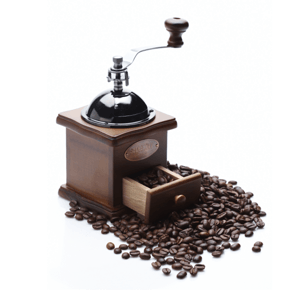What kind of Italian beans do we need?
Follow the caf é (Wechat official account vdailycom) and found that Beautiful Cafe opened a small shop of its own.
Individual coffee beans tend to show the unique characteristics of a certain type of coffee. And blended coffee, also known as mixed coffee, is to mix all kinds of single coffee beans together, so as to give full play to the strengths of various single coffee beans, learn from each other, or complement or strengthen each other in taste, thus creating a richer new taste of coffee. The three elements of Italian blending coffee, different from single coffee, Italian blending coffee not only let us begin to know more about coffee, carefully prepared coffee, is always beautiful.
Baking beans is like cooking delicious food, copying is already difficult, what is more difficult is how to avoid "one person's food is another person's poison." A good match should be "universal".
This is what individual coffee is not good at: some people prefer Kenyan berries, an ordinary Kenyan coffee can satisfy his taste buds, and the friend sitting opposite him, even if you explain the manor, say it is expensive, and guide it, it looks to him like cold tomato soup.
Speaking of universality, I made a recipe last year, and now there are already 100 customers purchasing this bean, from Harbin to Guangzhou, from Qinghai to Qingdao, which gives me the courage to share some experience here.

First, do not pursue sour quality too much
Coffee roasting is roughly divided into three roasting degrees: light roasting (pursuing the floral and herbal aromas of coffee); medium roasting (seeking nutty aromas and caramel aromas of coffee); and deep roasting (looking for spices, chocolate and resin aromas).
When making a custom formula for a customer in Guangxi this year, they said that they hoped to use Kenya and Costa Rica to do medium baking and get a formula with high acidity, because it is a professional restaurant, and the guests are heavy lovers of coffee who are used to acidity. If you use this formula in many stores, you will probably receive a lot of complaints.
In our customer survey, more than 70% of the guests do not like the obvious sour aroma in the coffee. Take a look at the high sales of deep-roasted Manning coffee in the whole market on Taobao.
So most of our mixed beans will be baked to 2 burst early stage to 2 burst density, this baking degree of Italian blending is still the mainstream of the market.
Second, if there is one taste that is the most universal, it is "sweet".
During the exhibition, I took out some test cups for enthusiasts to try. Regardless of the region and the price, the coffee we prefer always has an obvious sweet flavor.
Many baristas know that sour beans can improve the sweetness of coffee when mixed with milk, so it is not difficult to make a cup of everyone's favorite "sweet latte". You just need to ensure the quality of the milk and make it sour.
Unfortunately, for many stores, there are no conditions for two or three Italian bean grinders for production, so it is best to take into account the quality of espresso, black coffee, milk coffee and iced coffee.
In the procurement and baking operations over the years, several beans that show obvious sweetness in matching have been found: Nicaragua, Brazil's yellow bourbon and El Salvador. Of course, there are more than these beans to improve their sweetness, but it is gratifying that these three beans can also add points in alcohol thickness, so I suggest you try it. Because of the variety of procurement channels, the specific matching ratio and cup test results have to be actually tested.
Third, ignore "personal elegant demeanor", blending coffee is a "team", just do your job
I have a friend who is new to baking and excitedly shares it with beans. He says the recipe is full of good beans, including sun Yega, Kenya, Guatemala yellow honey, COE beans and 10% Panamanian roses.
These are beans that can detonate the whole audience. I asked him what kind of baking style he wanted to show. He said it was RMB, and we laughed awkwardly for a long time.
So before we start roasting coffee, we might as well ask ourselves, "what on earth did I shovel 1KG's Indonesian beans in for?"
Bakers need to have a detailed understanding of most coffee beans in the market, just like knowing at least how each ingredient is handled and tasted before cooking. In front of these sour, sweet, bitter, spicy and mellow ingredients, "what kind of style do I want to show in this recipe I'm going to make today?"
The job of trying the recipe is the real version of Breaking Bad, which aims to create your own and popular "private dish" through the running-in of coffee beans. What happens if you blend Colombian caramel to Costa Rican vanilla? Or the baking of the berry bomb from the sun to medium to deep baking can perfectly integrate the existing formula base? All these need to be explored in practice.
Italian caffeine is a concentrated essence, and all the flavors and defects in coffee beans will be magnified several times, so it is not easy to get a satisfactory Italian mix.
Each coffee shop will also spell out different proportions of coffee beans according to its own characteristics. Here are several representative mixed proportions. Of course, you can also challenge yourself to try to find the proportion you like.
I. espresso blending method: 70% in Colombia and 30% in Brazil
Second, mixed commercial coffee with bitter taste: 60% in Colombia, 20% in Brazil and 10% in Robusta, Indonesia.
There are two spelling methods for spelling beans: first bake, then mix and then bake, also known as cooked and cooked, which is a greater test for bakers; the purpose of raising the mixed beans for a few more days is to make the beans blend and have a balanced flavor; cooked beans usually take about a week; raw and mixed beans can be used in 3-4 days, because different beans are already affecting each other when baking.
Important Notice :
前街咖啡 FrontStreet Coffee has moved to new addredd:
FrontStreet Coffee Address: 315,Donghua East Road,GuangZhou
Tel:020 38364473
- Prev

The reason for the leading position of Kenyan Coffee in the World ranking
Follow Cafe (official Wechat account vdailycom) found that Kenya caffeine has opened a small shop of its own. The aroma, taste and quality of Kenyan caffeine are well received in the global market, but the industry has long been dominated by Western multinationals. According to market research, only six companies control about 60 to 70 percent of the trade in raw coffee in Kenya, ranking TAYLO WI in the United Kingdom.
- Next

Italian espresso extraction time powder standard Italian coffee bean formula sharing
Follow the caf é (official Wechat account vdailycom) and find that if you love coffee in a beautiful cafe, you must want to assemble an exclusive recipe of your own. The blending of coffee should also be adjusted and changed according to the season of coffee production. New beans and Chen beans have differences in flavor.
Related
- Detailed explanation of Jadeite planting Land in Panamanian Jadeite Manor introduction to the grading system of Jadeite competitive bidding, Red bid, Green bid and Rose Summer
- Story of Coffee planting in Brenka region of Costa Rica Stonehenge Manor anaerobic heavy honey treatment of flavor mouth
- What's on the barrel of Blue Mountain Coffee beans?
- Can American coffee also pull flowers? How to use hot American style to pull out a good-looking pattern?
- Can you make a cold extract with coffee beans? What is the right proportion for cold-extracted coffee formula?
- Indonesian PWN Gold Mandrine Coffee Origin Features Flavor How to Chong? Mandolin coffee is American.
- A brief introduction to the flavor characteristics of Brazilian yellow bourbon coffee beans
- What is the effect of different water quality on the flavor of cold-extracted coffee? What kind of water is best for brewing coffee?
- Why do you think of Rose Summer whenever you mention Panamanian coffee?
- Introduction to the characteristics of authentic blue mountain coffee bean producing areas? What is the CIB Coffee Authority in Jamaica?

